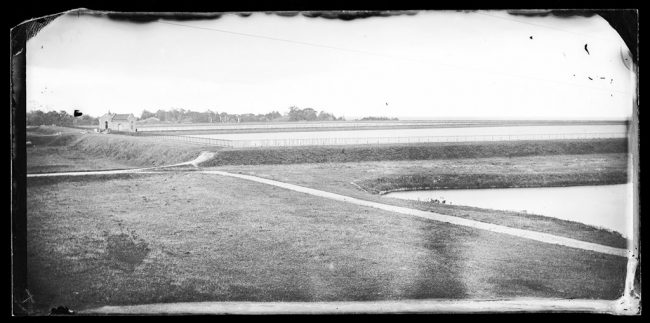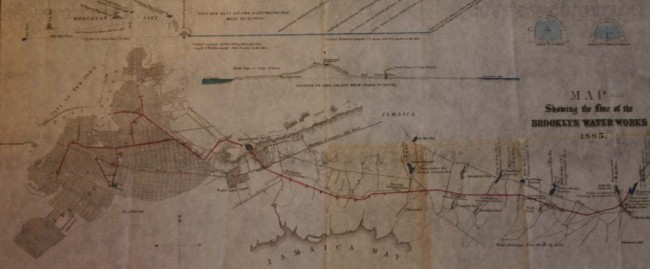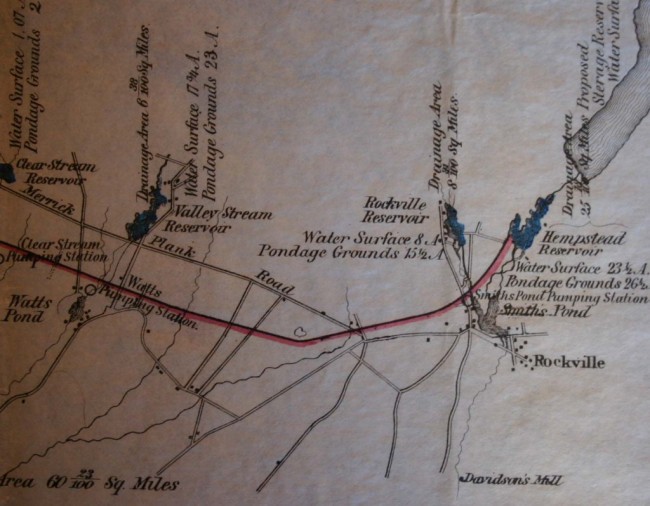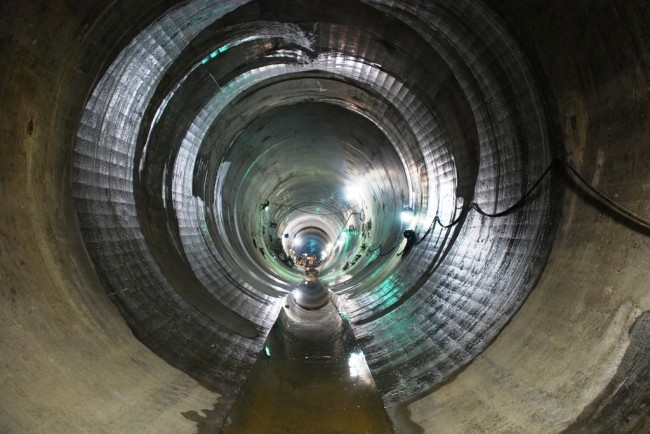
We are celebrating 15 years — and counting — of stories that are deeply researched and deeply felt, that build a historical record of what the city has been.
We are celebrating 15 years — and counting — of stories that are deeply researched and deeply felt, that build a historical record of what the city has been.
The crowd was surprisingly large for a Friday night lecture. Students, scientists, hobbyists, historians, and just about every brand of urbanist were in attendance. We came to hear Dr. Jeffrey Kroessler, a historian and preservationist, give his take on the history of Brooklyn’s water systems and their effect on the development of the city. The lecture was organized by NYC H20, a nonprofit devoted to educating the public on our city’s water and sewer systems. In keeping with its mission, NYC H20 put together a program with Dr. Kroessler that was both interdisciplinary and engaging, covering a nuanced history that dates back over 200 years.
When we think about water and the growth of cities, the first images that come to mind often feature explorers, tradespeople, or immigrants. What we now call New York City sits on a deep harbor that almost never freezes, making it an ideal port. However, the development of New York City, and Brooklyn in particular, has as much to do with the fresh water beneath it as the seas surrounding its shores.

Map showing the depth below the surface of the water table; red indicates less than eleven feet | Map via USGS
The nearness of that exceptional drinking water can be traced back to the Ice Age, almost 18,000 years ago. That was when a massive glacier began melting, creating a ridge of swept-up materials at its furthest advance, the middle of Long Island. To the south of that ridge (known as the terminal moraine), the runoff from the melting glacier washed away the hills, flattening the land and positioning the water table closer to the surface. When the Dutch claimed New Amsterdam in the 17th century, they easily accessed this water via a network of public wells, a practice that would continue until the 19th century.
We would all do well to spend a little more time thinking about the water that comes out of our taps.This system was far from perfect, however, and New York suffered as a result. Polluted water contributed greatly to frequent medical crises, and commerce began to migrate to Philadelphia where the water was cleaner and more pressurized. Before creating a fully fledged public water system, however, New York first flirted with privatizing its distribution. In the early 19th century, Aaron Burr incorporated the Manhattan Company, which promised to transport water from the Bronx River down to lower Manhattan. His company did little to live up to its promise, however, and Burr settled on creating a much smaller system around Fresh Water Pond in lower Manhattan. Dr. Kroessler produced a relic from this endeavor, a small section of a log that was no more than a foot in diameter with a four-inch hole bored through its center. This flimsy infrastructure was what the Manhattan Company put in place while it developed the more profitable banking side of its company, later known as Chase Manhattan Bank. (During the Q&A section of the lecture, a gentleman from the audience claimed that the Manhattan Company maintained the charade of being a water provider for decades for fear that its charter would be revoked.)
Realizing the need for a system that would better serve the public, New York City officials decided to build the Croton Aqueduct System in 1835, the same year a massive fire would raze 17 city blocks without any water to extinguish the flames. As the buildings burned, the insurance companies that covered them went bankrupt, sending a ripple effect through the economy. Nevertheless, construction began on the Croton Aqueduct System two years later in 1837, only to be later supplemented by the Catskill and Delaware systems in the 20th century.

Ridgewood Reservoir, ca. 1872-1887 | Photo by George Bradford Brainerd, courtesy of the Brooklyn Museum
Seeing the mistakes that were made with the Manhattan Company, the Brooklyn Common Council avoided the pitfalls of private interests when approached by entrepreneurs offering to sell them water from wells in Williamsburg. Taking advantage of the undercapitalization of the small company, the Council annexed what was then the City of Williamsburg and began pumping water for itself. The city tore up mile after mile of field and roadway in order to create a path to the Ridgewood Reservoir, which broke ground in 1856 on top of the terminal moraine at the meeting point of Brooklyn and Queens. When the water began flowing in January of 1859, it did so from the Ridgewood Reservoir down through Cypress Hills where it was dispatched to distributing reservoirs. One can see some of these older, beautifully constructed systems in photography of urban spelunker Steve Duncan.
Brooklyn’s transition to a larger public water system was not without its hiccups, however. One of the arguments for the City of Brooklyn to consolidate with the City of New York in 1898 was its need for a larger water supply, but it would be years before the borough would get it. As soon as Brooklyn began pumping water to its residents in the late 19th century, Long Island farmers suddenly found themselves without enough water pressure to work their mills and irrigate their fields. Water sources that were vital to Long Island’s economy began to dry up, and the ensuing conflict between public and private sectors came to a head in Resiert v. The City of New York. In 1901, a Long Island farmer named Frederick Resiert sued New York City for depriving him of the stream that irrigated his farmland. He received a mere $90 from the court to dig a deeper well, a decision Resiert appealed and won several cases. After 10 years of fighting, however, Resiert was foiled by Tammany Hall politicians, who hired scientists to argue that his claims were unfounded. They won, and Resiert’s previous wins were overturned. Though the City of New York won the case, it was nevertheless apparent that Brooklyn’s demand for water had grown too big for its supply, and in 1917 Brooklyn finally gained full access to New York City’s water systems.

Map showing the line of the Brooklyn Water Works, 1889 | Image via Brooklyn Historical Society

Detail of map showing the line of the Brooklyn Water Works, 1889 | Image via Brooklyn Historical Society
Recently, much attention has been paid to pressing urban issues like rising storm water, but it seems as though we take for granted our access to potable fresh water. One look through the history of New York’s water systems — such as the one recounted by Dr. Kroessler and summarized above — quickly proves that these systems are not static, and that they have far-reaching political as well as ecological implications. It should be common knowledge that the Delaware Aqueduct, which transports half of New York’s water, is leaking and will need repairs in the next 10 years. The City is scrambling to save water and shore up alternative sources like the Croton aqueduct system, preparing for what may be a long-term water shortage. The public should also know about Water Tunnel No. 3, the largest capital construction project in New York’s history with an investment of over $4.7 billion to date. Even Mayor Bloomberg, whose administration provided consistent funding for the project, admitted, “it’s not sexy, and nobody says thank you.” This system, however, will provide much needed support for New York’s other two water tunnels in Manhattan, which haven’t been serviced in over seventy years. Besides the future of our city’s water, we also need to keep our eyes on the infrastructure of the past. Dr. Kroessler’s lecture was replete with slides of ruined would-be landmarks like the Ridgewood and Milburn Pumping Stations (demolished in 1940 and 2010, respectively). Today, we should focus our attention on what’s left, like the Ridgewood Reservoir, which is now a part of the Atlantic Flyway and hosts over 150 species of birds.
Whether you’re an environmentalist, conservationist, political theorist, or general resident — we would all do well to spend a little more time thinking about the water that comes out of our taps. As Dr. Kroessler emphasized at the beginning of his lecture, you cannot untangle the history of New York’s growth from that of its water systems.

City Water Tunnel No. 3 | Image via NYC Department of Environmental Protection
The views expressed here are those of the authors only and do not reflect the position of The Architectural League of New York.